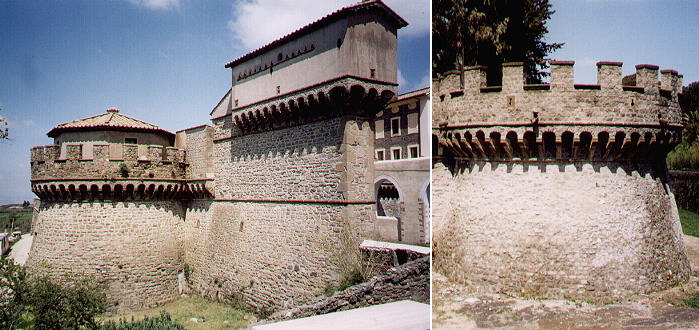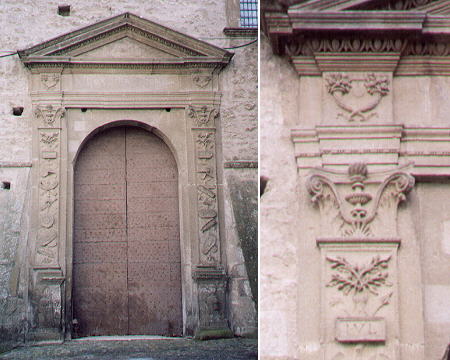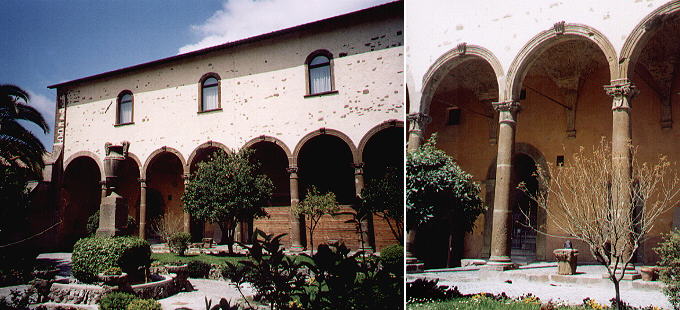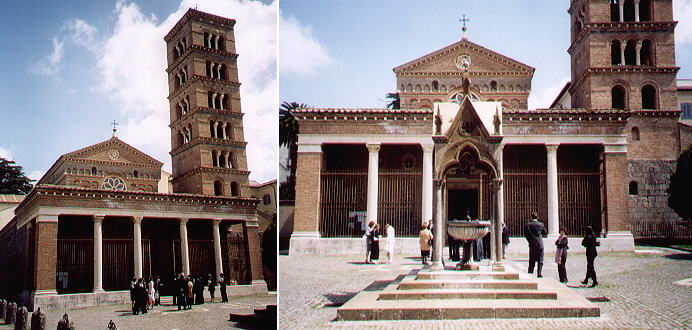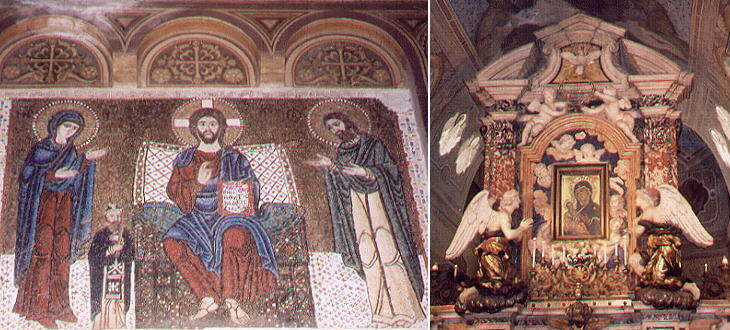

Grottaferrata is a small town which developed around an abbey founded in 1004 by St. Nilus a monk from Calabria, who
followed the rules set by St. Basil. In the late XVth century the abbey was fortified by Cardinal Giuliano Della Rovere,
nephew of Pope Sixtus IV, who became
Pope Julius II in 1503.
Fortifications of Grottaferrata
The fortifications were probably meant for the protection of the cardinal himself, more than for the abbey.
The cardinal had a difficult relationship with Pope Alexander VI Borgia and the fortified abbey could provide him with a secure haven in
case of need. The fortifications were most likely designed by Giuliano da Sangallo or by Baccio Pontelli and they were expected to
resist the impact of artillery. Cardinal Della Rovere was bishop of Ostia and he had fortified that location with a small castle, now known as Castello di Giulio II.
Gate of the Abbey
The entrance to the abbey is framed by reliefs inspired by ancient Roman patterns, very often having a military subject and called
candelabra (chandelier) for their vertical alignment. A similar decoration can be found in
S. Aurea, the church of Ostia. Both the inscriptions above the entrance and those at its
sides make reference to Cardinal Della Rovere.
Main cloister
When we think of a cloister, we do not expect to see such high columns and harmonious vaults as those built by Cardinal Della Rovere.
S. Maria di Grottaferrata
The vestibule is the only part left of the ancient church as the interior was almost entirely
redesigned in 1754. The façade was modified in the XXth century and it was given a medieval appearance.
The fine bell tower is dated XIIth century.
Mosaic above the entrance and main altar
In the early XIXth century travellers came to Grottaferrata to see the frescoes by Domenichino
in a separate chapel of the church: at that time Domenichino and Guido (as Guido Reni was called) were
considered the last great Italian painters before the Decadence (i.e. the Baroque period). Later on in the XIXth century the admiration for Domenichino faded away (read Henry James' account of his visit to Grottaferrata).
The vestibule retains a very fine old mosaic showing the Saviour between the Virgin and St. John: the monk portrayed at a smaller scale
is St. Nilus. The sacred image worshipped in the church (a Greek icon) is framed by a very richly decorated Baroque altar.
Excerpts from Giuseppe Vasi 1761 Itinerary related to this page:
S. Maria di Grotta Ferrata
Correva il decimo secolo della nostra salute, quando Agareno Arabo, soggiogava tutta la Calabria, con una fierissima persecuzione contro
i Cristiani; ma molto più contro i monaci, e religiosi, ed essendo in quella Provincia per il timore disertati tutti i monasterj, e romitorj,
s. Bartolommeo Nileo discepolo di s. Nilo monaco dell'Ordine di s. Basilio, scelse 60. de' suoi monaci di rito greco, e fuggendo le crudeltà
del Barbaro predatore, se ne venne nel Lazio per servire Iddio in santa pace. Giunto nell'ameno campo in vicinanza del Tusculo, quasi per
divino istinto fu guidato ad una sa grotta, che ancora oggidì si vede, dove insieme co' suoi religiosi si ricoverò; e dormendo in essa con
tutti gli altri compagni, gli apparve la ss. Vergine dicendoli, che ivi si fermasse, e vi fabbricasse una chiesa in suo onore.
Dominavano allora nel Tusculo undici Conti di grande autorità e possanza, i quali avendo avuto la stessa visione, non solamente
somministrarono i sussidj per la fabbrica della chiesa e monastero; ma con somma generosità provvidero loro di rendite per lo mantenimento
di cento Monaci sotto la condotta di s. Bartolommeo loro primo Abate, e fondatore. Questi datosi subito a fabbricare, operò quivi diversi
segnalati miracoli, e fra gli altri, che stando per cadere una delle otto colonne, che egli dalle rovine antiche, ivi cavate aveva, per ornarne
la chiesa, come ancora si vede, egli la fermò in aria col segno della santa Croce.
Crebbe poi a tal segno la devozione de' Fedeli verso quel santuario, che accrebbero quelle entrate alla somma di 60. mila scudi annui,
con 21. chiese e monasterj soggetti; arricchiti e segnalati con vari privilegj. Nulladimeno a poco a poco mancato il fervore e la devozione;
massimamente in occasione dello scisma tra la Chiesa Greca, e la Latina nell'anno 1462. alli 28. di Agosto su quel monastero da Pio II. ridotto
in commenda Cardinalizia, onde molti Cardinali Commendatarj hanno ristaurata, ed ornata la chiesa con marmi, sculture, e pitture insigni,
tenendosi in gran conto quelle nella cappella laterale dipinte a fresco dal Domenichino, per commissione del Card. Farnese, mentre era
Commendatario di quel monastero, ora ridotto a pochi monaci.
|
Next step in your tour of the Environs of Rome: Marino
See my Home Page on Baroque Rome or my
Home Page on Rome in the footsteps of an
XVIIIth century traveller.
|


